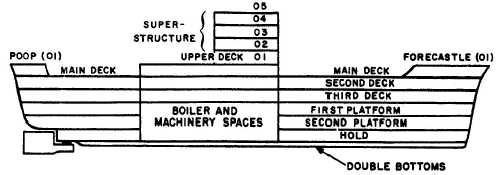| |
The complete decks below the main deck (fig. 17-2)
are the second deck, third deck, and so forth.
Partial decks that do not extend continuously from
bow to stern have special names, such as the
following:
Forecastle deck: A partial deck above the main deck
at the bow. It is used primarily on merchant ships
and is designated the 01 level on naval ships.
Upper deck: Above the main deck from the bow to
abaft amidships on merchant ships. It is referred to
in naval ships as the 01 level. Succeeding levels above
are named the 02 level, 03 level, and so forth.
Poop deck: Above the main deck in the stern, usually
only in merchant ships. It is designated the 01 level
on naval ships.
Platform deck: Below the lowest complete deck.
Platforms are numbered downward, such as first
platform, second platform, and so on.
Miscellaneous working platforms or flats
consisting of gratings are located in the machinery
spaces. These platforms aid in the access to and
operation of the ship’s propulsion equipment.
In addition to the foregoing nomenclature,
some decks are known by names describing their use
or function. In aircraft carriers the uppermost
complete deck is the flight deck, and the deck
immediately below it is the gallery deck. The main
deck is known as the hangar deck. The levels or
decks above the hangar (main) deck are called the 01
level (first level above the hangar) and the 02 level
(second level above the hangar), The gallery deck is
also known as the 03 level and the flight deck as the
04 level.
COMPARTMENTATION
A cargo ship has only a few decks, and its
bulkheads
are
widely
spaced.
The
resulting
compartments are identified by their primary purpose,
such as cargo holds. In some cases, cargo holds are large
enough to accommodate many tons of cargo. Passenger
ships have smaller holds, the remainder of the space
being divided by decks and bulkheads into smaller living
compartments for passengers. Naval ships are usually
more extensive y compartmented than merchant ships.
Their watertight compartmentation is more than a
matter of dividing or segregating various activities
aboard ship. The ability of a naval ship to withstand
damage depends largely upon its compartmentation. In
case of damage, the watertight boundaries of the
compartments restrict floodwaters and stand as a
barrier between them and the undamaged portion of the
vessel. Extensive compartmentation lessens the amount
of seawater that will enter the vessel through a rupture
in its shell plating.
Watertight Integrity
If a compartment is not watertight, it is
useless as a flood barrier. The quality of
watertightness is known as watertight integrity. The
greater the watertight integrity of a compartment,
the more effectively it limits flooding. The battle to
maintain the watertight integrity of the ship as a
whole is a complicated and never-ceasing one. Many
members of a ship’s crew spend hours patrolling and
inspecting the ship to maintain its watertight
integrity and keep it in battle trim.
Figure 17-2.—Decks and platforms divide the ship into tiers of compartments.
17-4
|

